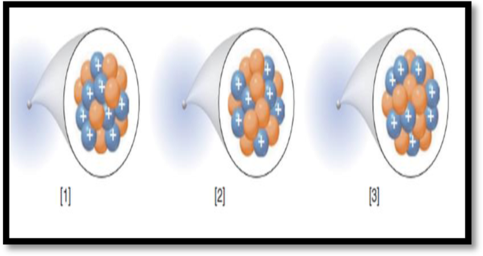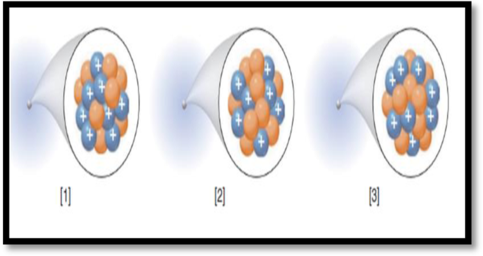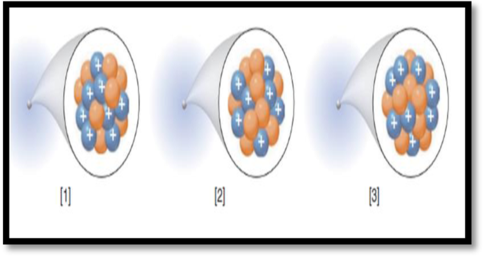
Concept explainers
(a)
Interpretation:
The species with highest mass number among the given figure has to be given.
The given figure is,

Figure 1
Concept Introduction:
Mass number (A):
Mass number of an element is defined as the total number of protons and neutrons in an atom.
(b)
Interpretation:
The number of electrons in each species given in the representation has to be given.
The given figure is,

Figure 1
Concept Introduction:
Electrons:
Electrons have an electric charge of
(c)
Interpretation:
The isotopic symbol of each species in the given figure has to be given.
The given figure is,

Figure 1
Want to see the full answer?
Check out a sample textbook solution
Chapter 2 Solutions
PRIN.OF GENERAL,ORGANIC+BIOLOG.CHEM.
- pls helparrow_forwardIndicate the compound resulting from the bromination of 3,5-dimethylpyrazolearrow_forward31) The reaction profile for a given chemical reaction is shown below A Energy Reactants Products B Progress of reaction a. Which arrow represents the activation energy for the forward reaction? b. Which arrow represents the activation energy for the backward reaction? c. Is the forward reaction exothermic or endothermic? d. Is the reverse reaction exothermic or endothermic?arrow_forward
- pls helparrow_forward10) What is the [OH-] concentration of a solution with a pH of 12.0? 1.0 x 10¹² M a. b. 1.0 x 10-12 M C. 1.0 x 10² M d. 1.0 x 102M 11) In which block of the periodic table would you find the element gold? a. b. s block P block C. d block d. f blockarrow_forward5) Who was responsible for the first model of the atom that included electrons? a. Dalton b. Thomson c. Bohr d. Rutherford 6) Which of the following rate laws is a fourth-order reaction? a. r = k[X][Y]²[Z] b._r= k[X]²[Y]³ C. r = k[X][Y]² d._r= k[X][Y]²[Z]ª 7) The activation energy of a particular reaction will decrease if: a. A catalyst is used. b. Temperature is increased. c. Reactant concentration is increased. d. All of the abovearrow_forward
- pls helparrow_forwardState the reason why compound A (m.p. 99-100°C) is heated under vacuum.1. So that the sample heating temperature is not too high when heated under vacuum.2. So that the temperature is higher than the melting point of compound A.3. So that cold water is not required in the sublimator.arrow_forwardTo find the theoretical % yield of a given reaction:1. actual amount obtained once crystallized2. (actual amount obtained / theoretical amount) x 1003. maximum amount of product that can be obtained / amount of initial reactantarrow_forward
- The reason activated carbon decolorizes and purifies a product is:1. It helps dissolve the product and then recrystallize it.2. It reacts with impurities in the product and removes them.3. It retains impurities by adsorption, purifying the product.arrow_forwardThe principle of a rotary evaporator is the same as that of:1. vacuum distillation2. reflux3. fractional distillationarrow_forwardAnhydrous MgSO4 is used to:1. Form a salt with the compound dissolved in the solution2. Remove water from a solution3. Neutralize a solutionarrow_forward
 Introductory Chemistry: A FoundationChemistryISBN:9781337399425Author:Steven S. Zumdahl, Donald J. DeCostePublisher:Cengage Learning
Introductory Chemistry: A FoundationChemistryISBN:9781337399425Author:Steven S. Zumdahl, Donald J. DeCostePublisher:Cengage Learning Chemistry: Principles and ReactionsChemistryISBN:9781305079373Author:William L. Masterton, Cecile N. HurleyPublisher:Cengage Learning
Chemistry: Principles and ReactionsChemistryISBN:9781305079373Author:William L. Masterton, Cecile N. HurleyPublisher:Cengage Learning Living By Chemistry: First Edition TextbookChemistryISBN:9781559539418Author:Angelica StacyPublisher:MAC HIGHER
Living By Chemistry: First Edition TextbookChemistryISBN:9781559539418Author:Angelica StacyPublisher:MAC HIGHER- Chemistry: Matter and ChangeChemistryISBN:9780078746376Author:Dinah Zike, Laurel Dingrando, Nicholas Hainen, Cheryl WistromPublisher:Glencoe/McGraw-Hill School Pub Co
 Chemistry: The Molecular ScienceChemistryISBN:9781285199047Author:John W. Moore, Conrad L. StanitskiPublisher:Cengage Learning
Chemistry: The Molecular ScienceChemistryISBN:9781285199047Author:John W. Moore, Conrad L. StanitskiPublisher:Cengage Learning





